The market of pharmacy delivery services exploded during the pandemic as many people were forced to stay at home and did not have access to traditional pharmacies. The research from Zion shows that the market of healthcare products delivery services is expected to reach $107.5 billion by 2025. Even after the COVID situation normalizes, the market of on-demand applications will remain relevant as customers will most likely continue to utilize delivery services in the future. How to start a pharmacy delivery service that saves time for both customers and pharmacists, streamlines the transactions, and gives people direct access to pharma experts via applications?
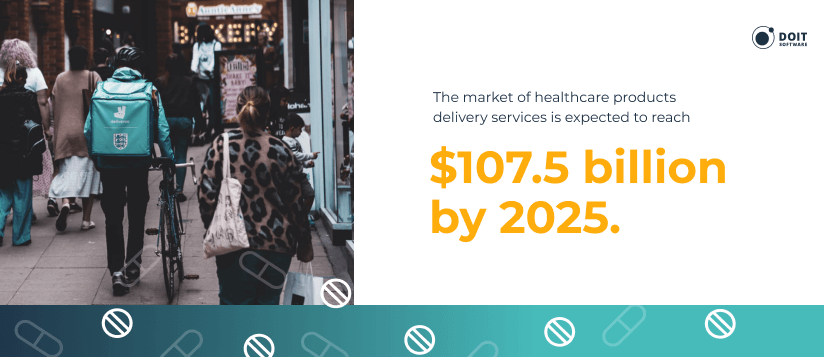
In this article, we will explore the success stories of the best e-pharma applications and try to figure out how they won over their customers. Furthermore, we will talk about the process of app development, discuss the core features, additional functionalities, technical stack, as well as app development costs. As a bonus, you will enjoy 7 things to consider before building a drug delivery application from our top specialists, including insights from real-life cases. We will share our process, budget estimates, screenshots, tips for monetization, business model guidelines, and more, to help you build a great tool. In other words, during the course of this helpful guide, we will answer the question of how to start a pharmacy delivery service.
On-demand applications have revolutionized the shopping experience throughout many industries, and pharmaceuticals are no exception. Until very recently, consumers did not have a choice but to use traditional pharmacies, but now they have the opportunity to use various tools and apps, including those powered by pharmaceutical software, to purchase prescription drugs at any time.
Customers can use apps for prescription delivery and over-the-counter drug purchasing to get access to a huge database of pharmaceuticals in their area. Such apps are very intuitive and easy to navigate, as they function similar to familiar shopping applications. Customers can browse through categories, add items to the cart, and then proceed to payment. Modern on-demand medicine delivery apps are highly secure and provide advanced safety payment options.
Before we talk about how to start a pharmacy delivery service, let’s answer the following question:
Why do customers prefer home delivery medicine apps to the brick-and-mortar experience?
Where there is demand, there is supply, and more and more pharmacy courier service applications emerge every day. We will talk about the top five pharmacy apps that have already made a splash on the market. And how do you to start a pharmacy delivery service like a pro?
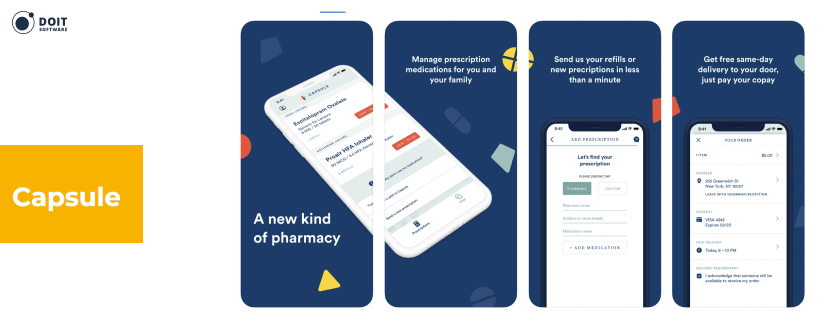
Total funding amount: $ 270 M
Features: Receive prescriptions directly from physicians; refills transfer; chat with pharmacists.
Business Model: Brick-and-mortar with online presence via website and application.
Monetization: In-app ads, sales revenue, delivery fees.
Downloads: Android: 1,000+, iOS: undisclosed
In 2015, Eric Kinariwala and Sonia Patel cofounded Capsule and made a significant breakthrough in the on-demand pharma market. Capsule is the Uber for the pharmacy industry as it is the most established medicine delivery mobile app there is. It operates in New York, Chicago, Los Angeles, Boston, Austin, and Minneapolis, and it continues to expand every year.
The company opens a single location in each city of the app’s availability, where it stores the pharmaceuticals. The stores are open to the customers, but they can also use the application to order healthcare products. The company will contact your insurance provider for you, to take care of the copayments, as well as get in touch with your doctor to collect the prescriptions. Available on both iOS and Android, the Capsule team also provides access to their top-notch pharmacists in order to answer any of your questions.
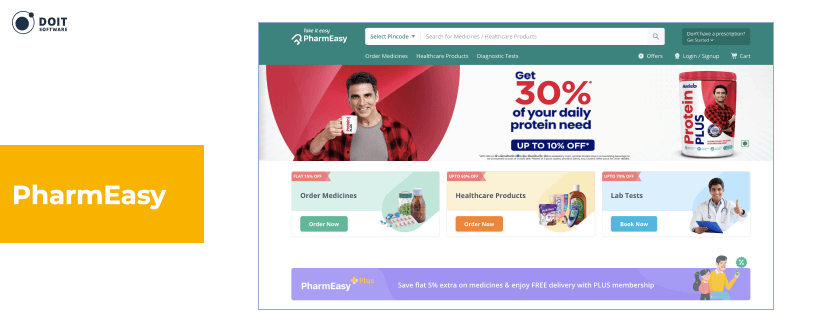
Total funding amount: $ 300 M
Features: Purchasing healthcare products and drugs; booking medical tests; drug delivery.
Business Model: Mediator between users and pharmacies.
Monetization: In-app ads, delivery fees.
Downloads: Android: 10,000,000+, iOS: undisclosed
Price: $50,000+
PharmEasy is a game-changer in the pharma market in India. Launched in 2014, PharmEasy has become the number one delivery app for medicines in India, with 90,000 retailers across the country. Besides offering over-the-counter and prescription drugs through the web and mobile app services, PharmEasy also provides direct bookings of various diagnostics tests.
The app for medicine home delivery always connects customers with the best offers, and provides discounts up to 15%. The delivery occurs 24 to 48 hours after placing the order. PharmEasy also gives access to detailed information about the drug, including side effects, instructions, warnings, and recommendations.
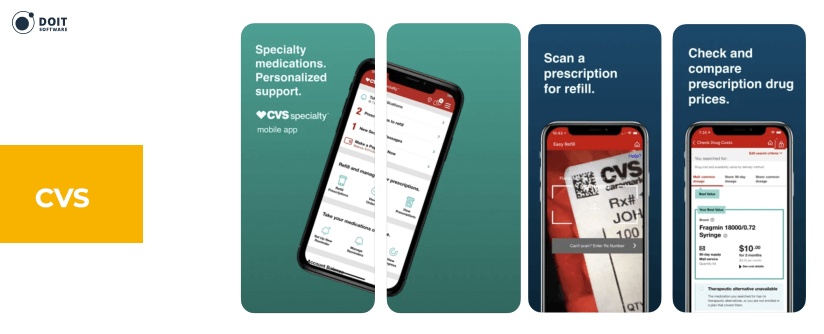
Total funding amount: $ 3 M
Features: Drug purchase and delivery; notifications; ExtraCare rewards; refill prescriptions; pill identifier
Business Model: Brick-and-mortar with online presence via website and application.
Monetization: In-app ads, sales revenue, delivery fees.
Downloads: Android: 10,000,000+, iOS: undisclosed
CVS is a company with a half-century history that has launched an application in 2012 to make its services available to more customers. CVS Pharmacy App is an over-the-counter and prescription delivery app that allows American residents to purchase drugs online. Besides providing access to their stores, experts, and detailed information about pharmaceuticals, the company has added a feature for visually impaired customers. The feature enables customers to read the label out loud to understand what exactly they are about to purchase.
The company has recently launched the CVS ExtraCare Program that provides loyal customers with rewards and extra offers to ensure the best experience and lowest prices. Depending on the location, CVS delivers on the same day or within 48 hours and offers both mobile and web applications.

Total funding amount: $ 117.8 M
Features: Personalized roll of pre-sorted medications; notifications, dashboards; chat with pharmacists.
Business Model: Mediator between users and pharmacies.
Monetization: In-app ads, delivery fees.
Price: $50,000+
PillPack is an Amazon medicine delivery app that takes the user experience to the next level.
Not only do they provide same-day delivery and competitive prices, but the company also takes it a step further. The pharmaceuticals are sorted out in separate packages with the day and time of intake. This practice prevents accidental overdoses and saves customers their time.
Patients can enter in their information, physician’s contact information, and insurance data, and the company will take care of the rest. Customers will receive the packages with everything they need, and on any day they want. The expertise and reputation that Amazon brings makes this online pharmacy delivery service application stand out and provide the ultimate customer experience.

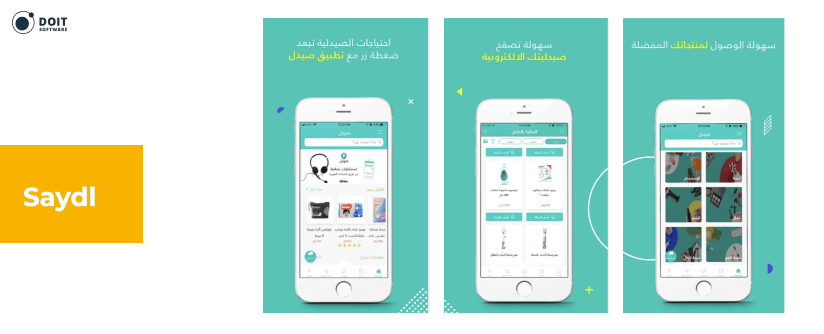
Features: Drugs purchase and delivery within 1 hour; access to a big variety of pharmacies.
Business Model: Mediator between users and pharmacies.
Monetization: In-app ads, delivery fees.
Saydl is the biggest prescription delivery app in Saudi Arabia. This company is a service that connects pharmacies and customers to guarantee the best experience for both. Saydl operates via a mobile app, where customers can find the medicine they need, upload a prescription, and order it for delivery to their homes. The tool also allows cash on delivery as a payment option and one-hour delivery.
Features: Encyclopedia with detailed description of drugs; pill identifier.
Business Model: Model based on donations and revenue from site advertisers.
Monetization: In-app and website ads, in-app upgrades
Downloads: Android: 1,000,000+, iOS: undisclosed
Drugs.com is a pharmaceutical Wikipedia where you can find detailed information about every type of medicine.
Features: Drug purchase and delivery within 24 to 48 hours; loyalty rewards; pill reminder.
Business Model: Mediator between users and pharmacies.
Monetization: In-app ads, delivery fees.
Downloads: Android: 50,000+
Price: $30,000
Another prominent Indian pharmacy mobile app is Medsonway. This service allows you to upload your prescription, place an order, and receive your drugs within 24 to 48 hours.
Features: Healthcare and drug purchase and delivery; communication with doctors via app.
Business Model: Mediator between users and pharmacies.
Monetization: In-app and website ads, delivery fees.
Downloads: Android: 500,000+, iOS: undisclosed
Yodawy is an Egyptian portal for healthcare and medical products that connects customers to over 4000 stores around the country.
Features: Reminders for refilling, medical appointments, drug taking
Business Model: Freemium model
Monetization: In-app ads and upgrades.
Downloads: Android: 50,000+, iOS: undisclosed
Price: $30,000 to $60,000
Pill Reminder is an easy-to-use app that helps users take their medicines on time via notifications.
The list goes on, with Ukrainian Liki24 that delivers pharmaceuticals across 27598 locations. This pharmacy service operates in Ukraine and Poland and helps customers find the most affordable product.
If you want to learn how to start a pharmacy delivery service like Liki24, Yodawy, or make your own unique app, keep on reading. Later in the article, we will talk more about features, technology stack, cost of development, and mention a few tips from our top experts.
Every medicine delivery app has a set of functional features, as well as non-essential ones that make an application unique. In this section, we will cover the core features on four sides of the application: customer, courier, pharmacist, and admin. Based on our previous experience and concrete projects, we will walk you through the guide of how to start a pharmacy delivery service.
In this section, we will focus on how to start a pharmacy delivery service and build the customer side of the application.
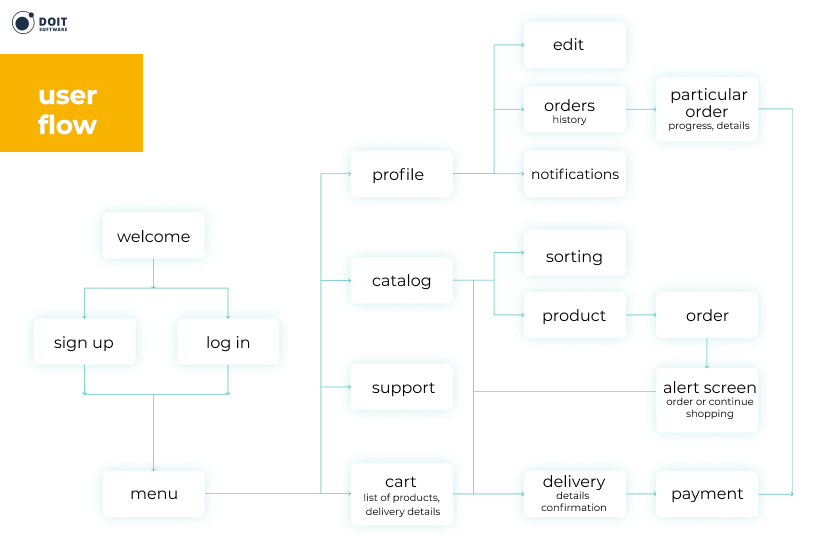
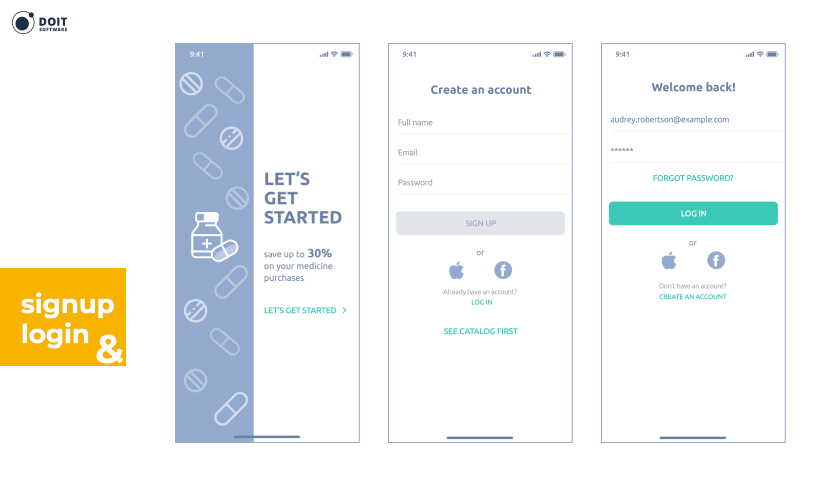
Users should be able to manually register an account and/or sign up via social media platforms like Google, Facebook, etc. Later, users are able to log into their accounts using their credentials such as email addresses or phone numbers. Modern apps should be easy to understand and sign up for, as users tend to abandon applications that require a long learning curve.
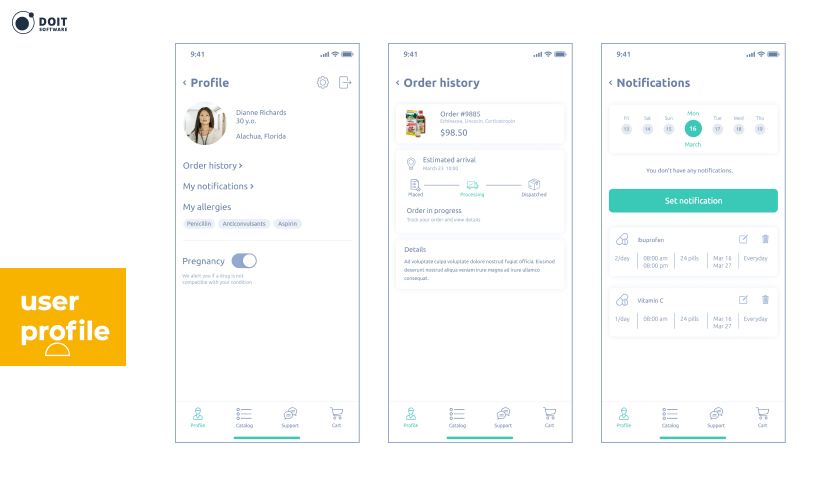
Users should be able to create a profile and fill it out to the extent that they need. The information should entail home address and payment details, as well as personal data like allergies, prescriptions, pregnancy status, and order history. It is very important to guarantee utmost data protection and compliance with laws like HIPAA.
The app should include a prescription pickup and delivery service, and have an easy way of uploading prescriptions to the database. The system should be able to gain access to the device’s gallery for a simple image upload. The function should be intuitive and easy to grasp, as without a prescription customers will not be able to order the drug that they need.
Create a medicine delivery app that provides an expansive search engine and allows customers to find the exact product they need. Customers should be able to browse through the entire list of medicines, sort them out by certain criteria, and provide recommendations. The list of products should be searchable by price, relevance, alphabet, category, and rating. Nowadays, medical supply delivery applications need to be inclusive and provide a voice search for visually impaired customers.
The product should be searchable, using keywords for both the brand and it’s components. On top of that, the search engine should begin to provide options after three symbols have been typed. Finally, users should be able to gain easy access to offers and discounts to get the best deals.
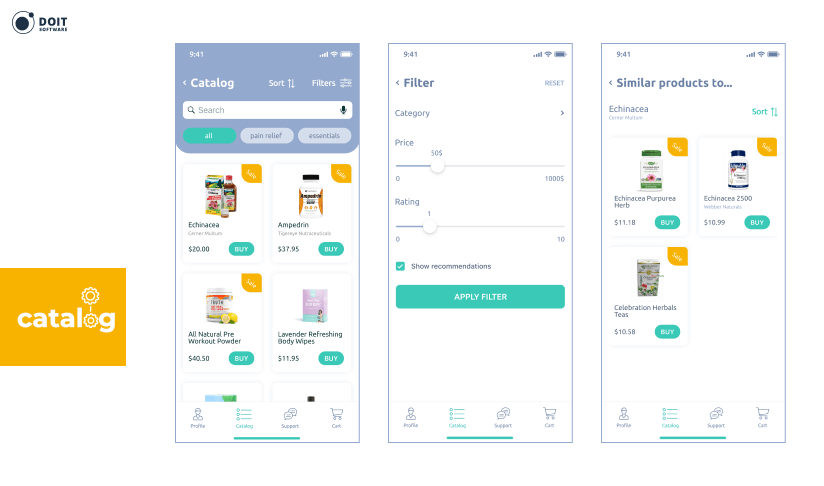
The Catalog is the inventory that your online store has to offer. Users must have easy access to the catalog and be able to browse through items, search for a specific product, sort and filter, as well as be able to read drug descriptions. To offer a more personalized approach, your app should look for similar products and offer them to the user as recommendations.
Users need to be able to tap into each product’s description and receive detailed information about the drug. Whether or not the drug may contain allergens, or there is a pregnancy warning, users with the relevant profile information should be immediately informed. Besides warnings, every product should be assigned an expiration date, manufacturer information, instruction, price, etc.

The shopping cart should be easy to spot and access, and include every item that was added. Customers should be able to change the number of the items, remove and add them. The information about the delivery fee, price per item, and the total of the cart should be visible and clear. Users should be able to add, remove or modify the delivery address and proceed with payment.
The application should redirect the user to the payment page once the cart has been confirmed. It is a good practice to provide several payment options, for example: PayPal, GPay, ApplePay, debit and credit cards, etc., to ensure that your customers can make a purchase using your tool.

If you want to learn how to accept recurring payments, check out this helpful guide from Chargebee:

Notifications are the best way to keep your customer base engaged and incentivize them to make purchases. You can notify them about new products, special offers, discounts, share medical articles and blogs, and provide coupons. Besides that, you can inform your recurring customers when it is time to refill their prescriptions.
Obviously, drugs cannot be returned, however, mistakes can happen and a pharmacy may send the wrong item, or the pharmaceutical courier may misplace and lose a product. In these unfortunate cases, your application needs a refund policy and customer support service. If a customer notices a mistake, they can quickly contact your customer support and receive immediate help.

Most users prefer to access customer support via chat rather than phone, which is why you need to create an easy-to-use communication tool that allows users to send direct messages to customer support personnel. Users should be able to send a voice message, attach files, images, and videos, as well as get a push notification in real-time when they receive an answer.
If you have more questions about the requirements for a user app and would like to clarify them with professionals, or you want to know more about how to start a pharmacy delivery service, please contact us at request@doit.software.
Here, we will dive into the pharmacy side of the solution and learn how to start a medical delivery service that helps pharmacies to increase their sales revenue, as well as reach a wider user base.
A pharmacy owner or manager should have easy access to the catalog to make certain modifications in case they run out of some products or the prices change. The owner should be able to access information about any products they sell and modify the description. The app could also be integrated with an inventory management tool to automate and optimize supply chain processes.
Pharmacists should be notified the second a new order comes through, which is why they need an order tracking system, as well as the notification system. The notifications may be sent through text messages, pop-ups, or any other way they deem convenient.
Order management involves receiving and processing the order as well as ensuring compliance with patient data protection regulations like HIPAA. Providing the utmost confidentiality when it comes to personal user data is always important, but in the medical industry it becomes the cornerstone. Non-compliance with HIPAA regulations may not only lead to financial burdens, but even legal repercussions. You can increase patient confidentiality and data security with integrated HIPAA eForms software. It provides a seamless way to capture and store patient information electronically, ensuring compliance with HIPAA regulations while enhancing the efficiency of pharmacy operations.
The pharmacist should be able to access payment information to make sure that the order has been paid for in full. The payment information should be sufficient for the pharmacist to know whether the payment has been made, but without details like card number, to ensure the security of the user data. If you would like to develop a medicine delivery app for a less digitally advanced country, where cash payments are still prevalent, you can also add a cash-on-delivery option.
Pharmacies need a clear communication channel with users to clarify their orders. Pharmacists should be able to reach their clients via chat, send images and documents, as well voice recordings to keep users up-to-date.
Pharmacists and pharmacy owners should be able to access reviews and ratings to receive proper feedback from the customers. Regular feedback collection will help them improve their services and increase the user experience. In case there is a bug in the program, pharmacy owners can get in touch with their prescription delivery app development partner to get it fixed as soon as possible.
Pharmacists need an analytics tool to keep track of sales, promotions, customer base, etc. Business analytics tools can give visual insights into the trends and market changes and identify opportunities. Besides, they allow a clear overview of the pharmacy's inventory, to guarantee that the stock is always sufficient.
How to start a delivery service for medical supplies and build the courier part of the pharmaceutical delivery service application? What features should it consist of?
Couriers should be able to get an account and enter all the information necessary for this job, including their bank account information to receive salary and tips. This is where the courier’s ratings, reviews, and order history will be stored in order to be accessed in case it’s needed.
When a customer places an order, the nearest courier should get a notification on his or her phone to proceed with delivery.
The Courier's side of the medicine delivery service app needs to have access to accurate navigation. It can be implemented in two ways:
1. Build a Route Management system with a custom map inside the app. It will take more time and require a bigger budget.
2. Integrate 3rd-party service API (like Geocoding API, Places API, Directions API, Distance Matrix API—all of which can be easily implemented by Google Maps experts). Also, use existing navigation solutions (like Waze, Google Navigation). It will be cheaper and faster to develop, but couriers should use both apps at the same time: navigator + pharmacy delivery app.
The main goal of both options serve - to track couriers' location as well as to help them find the right address and the optimal routes.
Every step of the delivery process, couriers need to be able to update the status of the delivery to keep the customer posted.
And finally, let’s discover the admin part of the solution, and learn how to start a pharmacy delivery service that entails sufficient managerial tools for inventory and marketing, as well as comprehensive dashboards to help businesses make better decisions.
The Admin’s side of the application requires a dashboard with all the relevant information, such as orders, deliveries, customers, external vendors, and so on.
Admin is in charge of making sure the physical stock correlates with the app selection. The Admin panel should contain the information about the current stock, as well as the expiration dates of each product to ensure the sale of valid drugs only.
Admins are in charge of marketing tools to promote products and attract more customers. Besides that, they should be equipped with business analytics tools to make data-driven business decisions.
Admins should have access to supplier and user information to collect relevant data and manage these relationships. If a supplier or customer has an issue, the admin is the one who will be contacted to solve it.
The Admin’s side of the medical delivery service app is responsible for making reports, which is why they need a comprehensive tool to collect important data, analyze key metrics, and generate visual reports.
How to start a medical courier service with advanced features that will stand out from the competition? Advanced features are the so-called “nice-to-have” features that are optional, especially in the early days, but they will make a difference in the long run. These include in-app chat options so that customers can get in touch with pharmacies and ask their medical questions. Another additional feature could be multi-currency support, especially if you operate in several countries. Having multi-lingual support will help you attract tourists and visitors who cannot get proper help at a traditional pharmacy.
Machine learning (ML) is a prominent technology that is being widely adopted across industries. For example, if you would like your app to send personalized recommendations based on previous purchase history, ML technology is for you. Predictive analytics is another ever-growing technology that helps companies recognize trends and act on them. By using predictive analytics, you can be ahead of the competition and make smart business decisions. Deep Learning is utilized for document recognition, and in this case, prescription recognition, to quicker and more accurately extract important information. The most technologically advanced apps offer a pill recognition feature that is also driven by Deep Learning.
AI-driven chatbots are also user experience boosters, and they simplify the way users interact with the app. Chatbots are usually capable of answering basic questions about the app, services, products, policies, etc., so that your customer support can concentrate on more serious problems.
Using our extensive experience, we will help you understand how to start a pharmacy delivery service that brings something unique to the market. Your decision depends on your budget and resources, but we suggest that you try to focus on functional features before moving on to non-functional ones.

Before choosing the right technology stack, you must decide on the type of application development you want to use. You can build a native solution or a cross-platform one. The difference is vast and will affect your technology stack, budget, HR resources, and timeline. When should you go for native application development and when should you opt for a platform-independent process? How to start a pharmacy delivery service with a native solution and also with a cross-platform tool?
Native app development is on average more expensive than a cross-platform one. This type of development requires medical delivery companies to build two separate solutions: one for iOS and one for Android. Launching two applications requires two development teams, coordinated timelines to ensure simultaneous release, and a 25-30% increased budget.
On the other hand, native development creates online medicine delivery apps with better user interface, higher performance, and stability, as well as an elevated user experience. Besides that, developers have access to native device’s features like camera and GPS and utilize them to make their solution better.
As we’ve already discussed earlier, a lot of factors determine the price and timeline of your project, including a number of platforms, custom interfaces for each app or universal design, etc. But usually, cross-platform app development enables faster development, reduces costs, and delivers two apps from a single code source. Even though you will need some native developers on your team to tweak the application to fit the platform-specific requirements, this type of development is more cost-effective and less time-consuming.
But cross-platform app development also has its drawbacks, and in this case, it is the overall performance levels of your app. Platform-independent apps are usually slower, provide limited functionality, and a poor user experience.
You can discuss your project with your software development partner and choose the corresponding technology stack. Depending on the development type, we can recommend the following technologies.
Front-End development
ReactJS or Flutter
Back-End development
NodeJS
API development
NodeJS
Stripe or PayPal for payment integration.
Google or OpenStreetMaps.
Delivery API (FedEx, UPS, USPS).
Twilio or Firebase messages, etc.
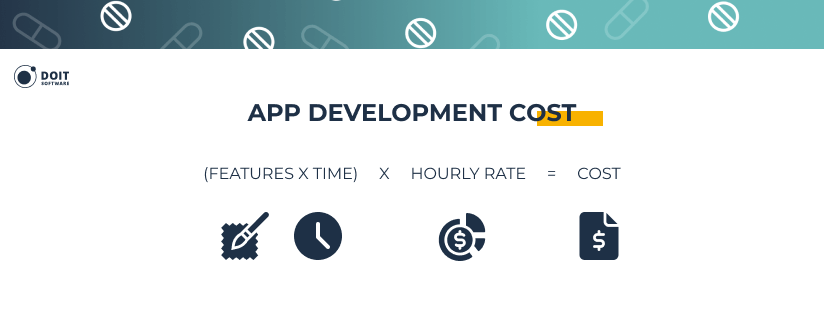
How to start a pharmacy delivery service on a budget? The development costs of a medical delivery services app depend on a number of factors.
USA
$75 - $150
Germany
$50 - $75
Eastern Europe
$40 - $65
India
$30- $40
How to start a pharmacy delivery service with a small to medium budget? Narrow down your search to companies from Eastern Europe or Asia, countries that offer lower prices. However, sometimes a lower fee might also mean poor quality, which is why you should be careful and choose your partner wisely.
So, how much does it cost to develop a pharmacy delivery service? Here, we divide the entire process into four steps, and calculate the timeline for each. Based on our projects, we can offer the following app development duration:
Both cross-platform and native development take roughly 31 weeks (7-8 months) to finish, however, native apps cost more: about $98,000 against about $88,500 for a cross-platform solution.
Let’s dive deeper into the pharmacy delivery service features costs:
The project discovery phase includes:
The discovery phase may take about 2-3 weeks and have a budget of about 6-8K USD.
Competitors analysis, detailed description of the main features' logic
6
Mind map creation
8
Prototype creation
52
The architecture of the solution creation & defining the technology stack
8
Proof-of-concept (Integration with pharmacy database)
16
Functional requirements (user stories)
32
Software requirements specification
6
Proto test
4
Development plan creation
4
Resources & communication plan
2
Accurate estimation
8
Communication
26
Total hours
172
The cross-platform app can be developed in 15-17 weeks and may cost you about 47-51K USD. Native app development will take the same 15-17 weeks but will have a higher budget of 55-61K USD.
Authorization
85 - 113
Profile
92 - 105
Notifications
141-164
Orders
78-92
Chat
213-233
Catalog
238-274
Cart
101-118
Init, app’s architecture and navigation
86-114
Bugfixing
206-243
Communication
186-218
Total, hours
1426-1674
It may take about 12 weeks and a budget of 28-31K USD.
Authorization
27
Admins
41-42
Pharmacies
299-303
Statistic
208
Project Init
16
Environment setup
12-16
Tech documentation
4
Bugfixing
122-123
Communication
110-111
Total, hours
839-850
To sum up, the pharmacy delivery service development with the described above functionality will cost you about $89-98K USD and will take 7-8 months. To get an accurate estimate based on your medical supply delivery product functionality, contact us.
As a software development company that has delivered a good number of various on-demand applications, we have accumulated a large knowledge base that we are ready to share. You can’t learn how to start a pharmacy delivery service without going through a few important steps, such as writing a prescription delivery service business plan, conducting market research, ensuring compliance with laws, etc. In this part, we will reveal our tips on how to start a medical supply delivery business.
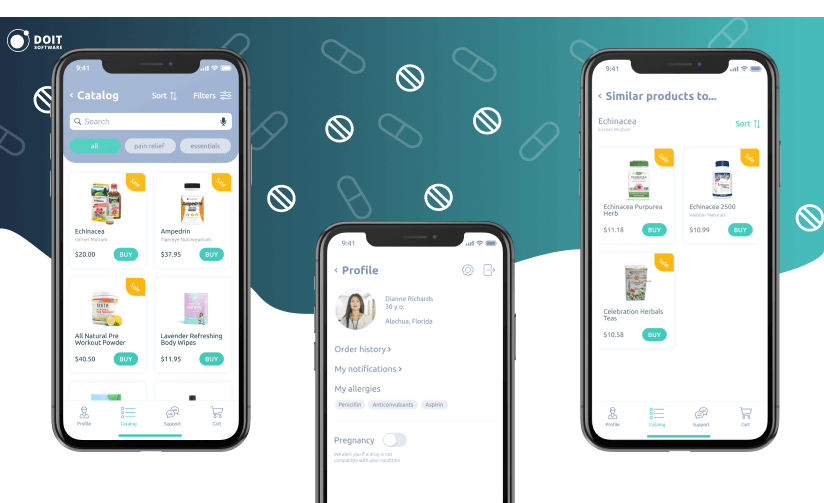
Much like with any other business, at first, you will need a business blueprint with detailed plans for monetization strategies, acquiring capital, advertising, medicine delivery services, and so on. The plan should entail every aspect of the business for the next five to ten years. Essentially, a business plan should communicate your company’s vision and goals and serve as a foundation for a potential financial investment. Engaging OGS business plan writers early in this process can ensure that your blueprint is not only comprehensive but also tailored to meet the unique challenges and opportunities in the pharmacy delivery industry.
Depending on your company’s model, your medical supplies delivery business plan can look very differently: you can be a third-party service that connects pharmacies to end-users or you can be a registered pharmacy that sells your own products. DOIT Software can offer a customer-oriented service and answer your questions on how to start a pharmacy delivery service, regardless of the business model you prefer.
To open a medical courier business, you need to thoroughly research the market. No matter how original your idea is, you will be penetrating some sector of the market and you need to learn all about the competition. How to start a pharmacy delivery service that stands out from the competition and offers something unique to the customers? Study your competitors, their strengths and weaknesses, and develop a unique value proposition to win over your potential audience. If you don’t know where to begin, take a look at our extensive market research at the very beginning of this article to get some pointers to how to start a pharmacy delivery service.

Compliance with laws and regulations takes a new meaning when it comes to the medical industry, as the cost of non-compliance can be someone’s health. So before you learn how to start a medicine business, make sure you know every law and regulation in the industry. As you will be processing and storing confidential information about customers’ health issues and prescriptions, you must ensure compliance with patient data regulations, such as HIPAA (US).
Besides that, your medical supply delivery business will be collecting and storing personal user data, such as address, contact information, and payment data, which also needs to be protected. Depending on your country, these laws vary, with GDPR in Europe, CCPA in the US, etc., so make sure you know which data privacy law is in effect in your region and ensure compliance with the law. Ask DOIT Software how to start a pharmacy delivery service that is compliant with all the regulations and rules.
If you are opening your own pharmacy to provide medical delivery services, you will need to obtain a formal license. For example, depending on your LLC location, the laws and regulations may differ, but you will most definitely need to be a professional pharmacist with a certification or degree. You also must get an Employer Identification Number if you plan to hire pharmacists. Contact the proper legal services to learn more about the specifics of the medicine delivery business in your country.
Find drivers who will work as pharmaceutical couriers at your company and provide proper training for them. It is especially important to teach them how to use your pharmacy delivery driver app so they can ensure smooth delivery services.
This section depends on your business model: if you are opening your own pharmacy, you will need to rent a storage facility, and if you are acting as a third-party service for an existing pharmacy, partner up with them to ensure a successful medical supply delivery service.
Looking for a storage facility with the right conditions might take some time, so use real estate agency services to find a proper place. If you decide to act as a mediator between pharmacies and consumers and provide only medical courier services, find a trustworthy pharmaceutical partner.
Finally, find the vehicles you would like to use for your medical courier services. The means of medical supply transportation are up to you and contingent on the location. Some towns are perfectly reachable by bicycles, some are better with the use of cars or maybe even public transportation, such as buses or the subway.
Learning about how to start a pharmacy delivery service is a long path, but today you took the first step toward building your own pharmacy app. Pinning down the entire journey from the business plan and taking it all the way to completion is a lengthy and cumbersome process. However, if you find the right software development partner, you will definitely get there much faster.
DOIT Software is a software development company that is ready to offer its extensive expertise in medical courier service development. Our best software engineers and business analysts will help you gather the essential information, guide you through the discovery phase, requirements collecting, development, testing, etc., including the ongoing support after the launch. Contact DOIT Software to receive a free consultation, quote and begin your new project. We will help you build the next Uber pharmacy delivery app.
Transform your idea into a successful product with the DOIT Software team.
Contact usA medicine delivery service app has four sides: customer, pharmacy, courier, and admin. Every side of the application has its own set of features that work together to see the whole process through: from the order placing to delivery.
This is how to start a pharmacy delivery service:
The most common monetization strategy for online pharmacy delivery is charging delivery fees. Besides that, third-party medical courier companies can advertise certain pharmacies in return for compensation. Finally, you can charge a commission to the pharmacies you deliver for.
The costs of the development of a medicine delivery driver app depend heavily on the location, complexity of the features, and your choice of platform. At DOIT Software, our high functional custom applications cost on average $88,500 for a cross-platform app and $98,000 for a native solution.










